An Agricultural Drought Index for Assessing Droughts Using a Water Balance Method: A Case Study in Jilin Province, Northeast China
Abstract
:1. Introduction
2. Materials and Method
2.1. Study Area
2.2. Datasets
2.2.1. In Situ Reference Data and Drought Indices
2.2.2. Remote Sensing Data
2.2.3. Soil Moisture
2.2.4. Field Drought Event Records
2.3. Data Pre-Processing
2.4. Methodology
2.4.1. Vegetation-Soil Water Deficit (VSWD)
2.4.2. Selection of Soil Moisture
2.4.3. Statistical Metrics
3. Results and Discussions
3.1. Spatio-Temporal Characterisation of Drought Using VSWD
3.2. Validating Indices Using Field Sampling Disaster Records
3.3. Comparison of VSWD with Other Drought Indices
3.4. Performance of Drought Indices in the Major Drought Events
4. Conclusions and Outlooks
Author Contributions
Funding
Conflicts of Interest
References
- Kogan, F.N. Global drought watch from space. Bull. Am. Meteorol. Soc. 1997, 78, 621–636. [Google Scholar] [CrossRef]
- Du, L.; Tian, Q.; Yu, T.; Meng, Q.; Jancso, T.; Udvardy, P.; Huang, Y. A comprehensive drought monitoring method integrating MODIS and TRMM data. Int. J. Appl. Earth Obs. Geoinf. 2013, 23, 245–253. [Google Scholar] [CrossRef]
- Chang, K.Y.; Xu, L.; Starr, G.; Kyaw Tha Paw, U. A drought indice reflecting ecosystem responses to water availability: The Normalized Ecosystem Drought Index. Agric. For. Meteorol. 2018, 250–251, 102–117. [Google Scholar] [CrossRef]
- Yang, J.; Chang, J.; Wang, Y.; Li, Y.; Hu, H.; Chen, Y.; Huang, Q.; Yao, J. Comprehensive drought characteristics analysis based on a nonlinear multivariate drought index. J. Hydrol. 2018, 557, 651–667. [Google Scholar] [CrossRef]
- Woli, P.; Jones, J.W.; Ingram, K.T.; Fraisse, C.W. Agricultural Reference Index for Drought (ARID). Agron. J. 2012, 104, 287–300. [Google Scholar] [CrossRef] [Green Version]
- Carrão, H.; Russo, S.; Sepulcre-Canto, G.; Barbosa, P. An empirical standardized soil moisture index for agricultural drought assessment from remotely sensed data. Int. J. Appl. Earth Obs. Geoinf. 2016, 48, 74–84. [Google Scholar] [CrossRef] [Green Version]
- Hao, C.; Zhang, J.; Yao, F. Combination of multi-sensor remote sensing data for drought monitoring over Southwest China. Int. J. Appl. Earth Obs. Geoinf. 2015, 35, 270–283. [Google Scholar] [CrossRef]
- Wilhite, D.A.; Glantz, M.H. Understanding the drought phenomenon: The role of definitions. Water Int. 1985, 10, 111–120. [Google Scholar] [CrossRef]
- Heim, R.R. A Review of Twentieth-Century Drought Indices Used in the United States. Bull. Am. Meteorol. Soc. 2002, 83, 1149–1166. [Google Scholar] [CrossRef] [Green Version]
- Vicente-Serrano, S.M.; Lorenzo-Lacruz, J.; Beguería, S.; Lorenzo-Lacruz, J.; Camarero, J.J.; López-Moreno, J.I.; Azorin-Molina, C.; Revuelto, J.; Morán-Tejeda, E.; Sanchez-Lorenzo, A. Performance of drought indices for ecological, agricultural, and hydrological applications. Earth Interact. 2012, 16, 1–27. [Google Scholar] [CrossRef]
- Martínez-Fernández, J.; González-Zamora, A.; Sánchez, N.; Gumuzzio, A. A soilwater based index as a suitable agricultural drought indice. J. Hydrol. 2015, 522, 265–273. [Google Scholar] [CrossRef]
- Wu, J.; Chen, X.; Yao, H.; Gao, L.; Chen, Y.; Liu, M. Non-linear relationship of hydrological drought responding to meteorological drought and impact of a large reservoir. J. Hydrol. 2017, 551, 495–507. [Google Scholar] [CrossRef]
- Lai, C.; Zhong, R.; Wang, Z.; Wu, X.; Chen, X.; Wang, P.; Lian, Y. Monitoring hydrological drought using long-term satellite-based precipitation data. Sci. Total Environ. 2019, 649, 1198–1208. [Google Scholar] [CrossRef] [PubMed]
- Palmer, W. Metreological Drought; Weather Bureau, US Department of Commerce: Washington, DC, USA, 1965.
- Bayarjargal, Y.; Karnieli, A.; Bayasgalan, M.; Khudulmur, S.; Gandush, C.; Tucker, C.J. A comparative study of NOAA–AVHRR derived drought indices using change vector analysis. Remote Sens. Environ. 2006, 105, 9–22. [Google Scholar] [CrossRef]
- Misshra, A.K.; Singh, V.P. A review of drought concepts. J. Hydrol. 2010, 391, 202–216. [Google Scholar] [CrossRef]
- Zhao, H.; Xu, Z.; Zhao, J.; Huang, W. A drought rarity and evapotranspiration-based index as a suitable agricultural drought indice. Ecol. Indic. 2017, 82, 530–538. [Google Scholar] [CrossRef]
- Halwatura, D.; Mcintyre, N.; Lechner, A.M.; Arnold, S. Capability of meteorological drought indices for detecting soil moisture droughts. J. Hydrol. Reg. Stud. 2017, 12, 396–412. [Google Scholar] [CrossRef]
- Dracup, J.A. Drought monitoring. Stoch. Hydrol. Hydraul. 1991, 5, 261–266. [Google Scholar] [CrossRef]
- Vogt, J.V.; Niemeyer, S.; Fabricius, K.E. Drought monitoring from space. In Drought and Drought Mitigation in Europe; Vogt, J.V., Somma, F., Eds.; Advances in Natural and Technological Hazards Research, vol 14; Springer: Dordrecht, The Netherlands, 2000; pp. 167–183. [Google Scholar]
- Steinemann, A.C.; Hayes, M.H.; Cavalcanti, L.F.N. Drought indices and triggers. In Drought and Water Crises. Science, Technology and Management; Wilhite, D., Ed.; Taylor & Francis: Boca Raton, FL, USA, 2005; pp. 72–85. [Google Scholar]
- Kallis, G. Droughts. Annu. Rev. Env. Resour. 2008, 33, 85–118. [Google Scholar] [CrossRef]
- Zhang, L.; Jiao, W.; Zhang, H.; Huang, C.; Tonga, Q. Studying drought phenomena in the Continental United States in 2011 and 2012 using various drought indices. Remote Sens. Environ. 2017, 190, 96–106. [Google Scholar] [CrossRef]
- Qin, Y.; Yang, D. Comparative analysis of drought based on precipitation and soil moisture indices in Haihe basin of North China during the period of 1960–2010. J. Hydrol. 2015, 526, 55–67. [Google Scholar] [CrossRef]
- Gibbs, W.J.; Maher, J.V. Rainfall deciles as drought indicators. In Australian Bureau of Meteorology Bulletin; No. 48; Commonwealth of Australia: Melbourne, Australia, 1967. [Google Scholar]
- McKee, T.B.; Doesken, N.J.; Kleist, J. The relationship of drought frequency and duration to time scales. In Proceedings of the Eighth Conference on Applied Climatology of the American Meteorological Society, Boston, MA, USA, 17–22 January 1993; pp. 179–184. [Google Scholar]
- McKee, T.B.; Doesken, N.J.; Kleist, J. Drought monitoring with multiple timescales. In Proceedings of the Ninth Conference on Applied Climatology of the American Meteorological Society, Boston, MA, USA, 15–20 January 1995; pp. 233–236. [Google Scholar]
- Keyantash, J.A.; Dracup, J.A. An aggregate drought index: Assessing drought severity based on fluctuations in the hydrologic cycle and surface water storage. Water Resour. Res. 2004, 40. [Google Scholar] [CrossRef] [Green Version]
- Shukla, S.; Wood, A.W. Use of a standardized runoff index for characterizing hydrologic drought. Geophys. Res. Lett. 2008, 35. [Google Scholar] [CrossRef] [Green Version]
- Madadgar, S.; Moradkhani, H. Spatio-temporal drought forecasting within Bayesian networks. J. Hydrol. 2014, 512, 134–146. [Google Scholar] [CrossRef]
- Lorenzo-Lacruz, J.; Vicente-Serrano, S.M.; López-Moreno, J.I.; Beguería, S.; García-Ruiz, J.M.; Cuadrat, J.M. The impact of droughts and water management on various hydrological systems in the headwaters of the Tagus River (central Spain). J. Hydrol. 2010, 386, 13–26. [Google Scholar] [CrossRef] [Green Version]
- Tian, L.Y.; Yuan, S.S.; Quiring, S.M. Evaluation of six indices for monitoring agricultural drought in the south-central United States. Agric. For. Meteorol. 2018, 249, 107–119. [Google Scholar] [CrossRef]
- Vicente-Serrano, S.M.; Beguería, S.; López-Moreno, J.I. A multi-scalar drought index sensitiveto global warming: The standardized precipitation evapotranspiration index–SPEI. J. Clim. 2010, 23, 1696–1718. [Google Scholar] [CrossRef]
- Yang, H.; Wang, H.; Fu, G.; Yan, H.; Zhao, P. A modified soil water deficit index (MSWDI) for agricultural drought monitoring: Case study of Songnen Plain, China. Agric. Water Manag. 2017, 194, 125–138. [Google Scholar] [CrossRef]
- Wells, N.; Goddard, S. A self-calibrating Palmer drought severity index. J. Clim. 2004, 17, 2335–2351. [Google Scholar] [CrossRef]
- Wang, H.; Rogers, J.C.; Munroe, D.K. Commonly used drought indices as indicators of soil moisture in China. J. Hydrometeorol. 2015, 16, 1397–1408. [Google Scholar] [CrossRef]
- Deepthi, R.; Vijay, P.S.; Ashok, K.M. Multivariate drought index: An information theory based approach for integrated drought assessment. J. Hydrol. 2015, 526, 164–182. [Google Scholar]
- Kogan, F.N. Application of vegetation index and brightness temperature for drought detection. Adv. Space Res. 1995, 15, 91–100. [Google Scholar] [CrossRef]
- Kogan, F.N. Droughts of the late 1980s in the United States as derived from NOAA polar-orbiting satellite data. Bull. Am. Meteorol. Soc. 1995, 76, 655–668. [Google Scholar] [CrossRef]
- Bhuiyan, C.; Singh, R.P.; Kogan, F.N. Monitoring drought dynamics in the Aravalli region (India) using different indices based on ground and remote sensing data. Int. J. Appl. Earth Obs. Geoinf. 2006, 8, 289–302. [Google Scholar] [CrossRef]
- Sandholt, I.; Andersen, J.; Rasmussen, K. A simple interpretation of the surface tenperature/vegetation index space for assessment of soil moisture status. Remote Sens. Environ. 2002, 79, 213–224. [Google Scholar] [CrossRef]
- Rebel, K.T.; de Jeu, R.A.M.; Ciais, P.; Viovy, N.; Piao, S.L.; Kiely, G.; Dolman, A.J. A global analysis of soil moisture derived from satellite observations and a land surface model. Hydrol. Earth Syst. Sci. 2012, 16, 833–847. [Google Scholar] [CrossRef] [Green Version]
- McVicar, T.R.; Jupp, D.L.B. The current and potential operational uses of remote sensing to aid decisions on drought exceptional circumstances in Australia: A review. Agric. Syst. 1998, 3, 399–468. [Google Scholar] [CrossRef]
- Hollinger, S.E.; Isard, S.A.; Welford, M.R. A New Soil Moisture Drought Index for predicting crop Yields. In Proceedings of the Eighth Conference on Applied Climatology, Anaheim, CA, USA, 17–22 January 1993; American Meteorological Society: Boston, MA, USA, 1993; pp. 187–190. [Google Scholar]
- Torres, G.M.; Lollato, R.P.; Ochsner, T.E. Comparison of drought probability assessments based on atmospheric water deficit and soil water deficit. Agron. J. 2013, 105, 428–436. [Google Scholar] [CrossRef]
- Keshavarz, M.R.; Vazifedoust, M.; Alizadeh, A. Drought monitoring using asoil wetness deficit index (SWDI) derived from MODIS satellite data. Agric. Water Manag. 2014, 132, 37–45. [Google Scholar] [CrossRef]
- Rhee, J.; Im, J.; Carbone, G.J. Monitoring agricultural drought for arid and humid regions using multi-sensor remote sensing data. Remote Sens. Environ. 2010, 114, 2875–2887. [Google Scholar] [CrossRef]
- Zhang, A.; Jia, G. Monitoring meteorological drought in semiarid regions usingmulti-sensor microwave remote sensing data. Remote Sens. Environ. 2013, 134, 12–23. [Google Scholar] [CrossRef]
- Ghulam, A.; Qin, Q.; Teyip, T.; Li, Z.L. Modified perpendicular drought index (mpdi): A real-time drought monitoring method. ISPRS J Photogramm. Remote Sens. 2017, 62, 150–164. [Google Scholar] [CrossRef]
- Zhang, Q.; Yu, H.; Sun, P.; Singh, V.P.; Shi, P. Multisource data based agricultural drought monitoring and agricultural loss in China. Glob. Planet Chang. 2019, 172, 298–306. [Google Scholar] [CrossRef]
- Yang, G.Y.; Shao, W.W.; Wang, H.; Han, D.M. Drought Evolution Characteristics and Attribution Analysis in Northeast China. Procedia Eng. 2016, 154, 749–756. [Google Scholar] [CrossRef]
- Cong, D.M.; Zhao, S.H.; Chen, C.; Duan, Z. Characterization of droughts during 2001–2014 based on remote sensing: A case study of Northeast China. Ecol. Inform. 2017, 39, 56–67. [Google Scholar] [CrossRef]
- Guo, E.L.; Liu, X.P.; Zhang, J.Q.; Wang, Y.F.; Wang, C.L.; Wang, R.; Li, D.J. Assessing spatiotemporal variation of drought and its impact on maize yield in Northeast China. J. Hydrol. 2017, 553, 231–247. [Google Scholar] [CrossRef]
- Zargar, A.; Sadiq, R.; Naser, B.; Khan, F.I. A review of drought indices. Environ. Rev. 2011, 19, 333–349. [Google Scholar] [CrossRef]
- Dai, A.G.; National Center for Atmospheric Research Staff (Eds.) The Climate Data Guide: Palmer Drought Severity Index (PDSI). Available online: https://climatedataguide.ucar.edu/climate-data/palmer-drought-severity-index-pdsi (accessed on 12 July 2017).
- Rouault, M.; Richard, Y. Intensity and spatial extension of droughts at different time scale since 1921 in South Africa. In Proceedings of the EGS—AGU—EUG Joint Assembly, Nice, France, 6–11 April 2003. [Google Scholar]
- Rodell, M.; Houser, P.R.; Jambor, U.; Gottschalck, J.; Mitchell, K.; Meng, C.-J.; Arsenault, K.; Cosgrove, A.; Radakovich, J.; Bosilovich, M.; et al. The Global Land Data Assimilation System. Bull. Am. Meteorol. Soc. 2004, 85, 381–394. [Google Scholar] [CrossRef] [Green Version]
- Zhang, X.Y. Crop Roots and Soil Water Utilization; China Meteorological Press: Beijing, China, 1999; pp. 1–186. [Google Scholar]
- Allen, R.G.; Pereira, L.S.; Raes, D.; Smith, M. CropEvapotranspiration-Guidelines for Computing Crop Water Requirements-FAO Irrigation and Drainage Paper 56; FAO: Rome, Italy, 1998; p. 5109. [Google Scholar]
- Peng, Y.; Long, S.; Ma, J.; Song, J.; Liu, Z. Temporal-spatial variability in correlations of drought and flood during recent 500 years in Inner Mongolia, China. Sci. Total Environ. 2018, 633, 484–491. [Google Scholar] [CrossRef]
- Yang, T.; Wang, X.Y.; Zhao, C.Y.; Chen, X.; Yu, Z.B.; Shao, Q.X.; Xu, C.-Y.; Xia, J.; Wang, W. Changes of climate extremes in a typical arid zone: Observations and multimodel ensemble projections. J. Geophys. Res. 2011, 116, 19. [Google Scholar] [CrossRef]

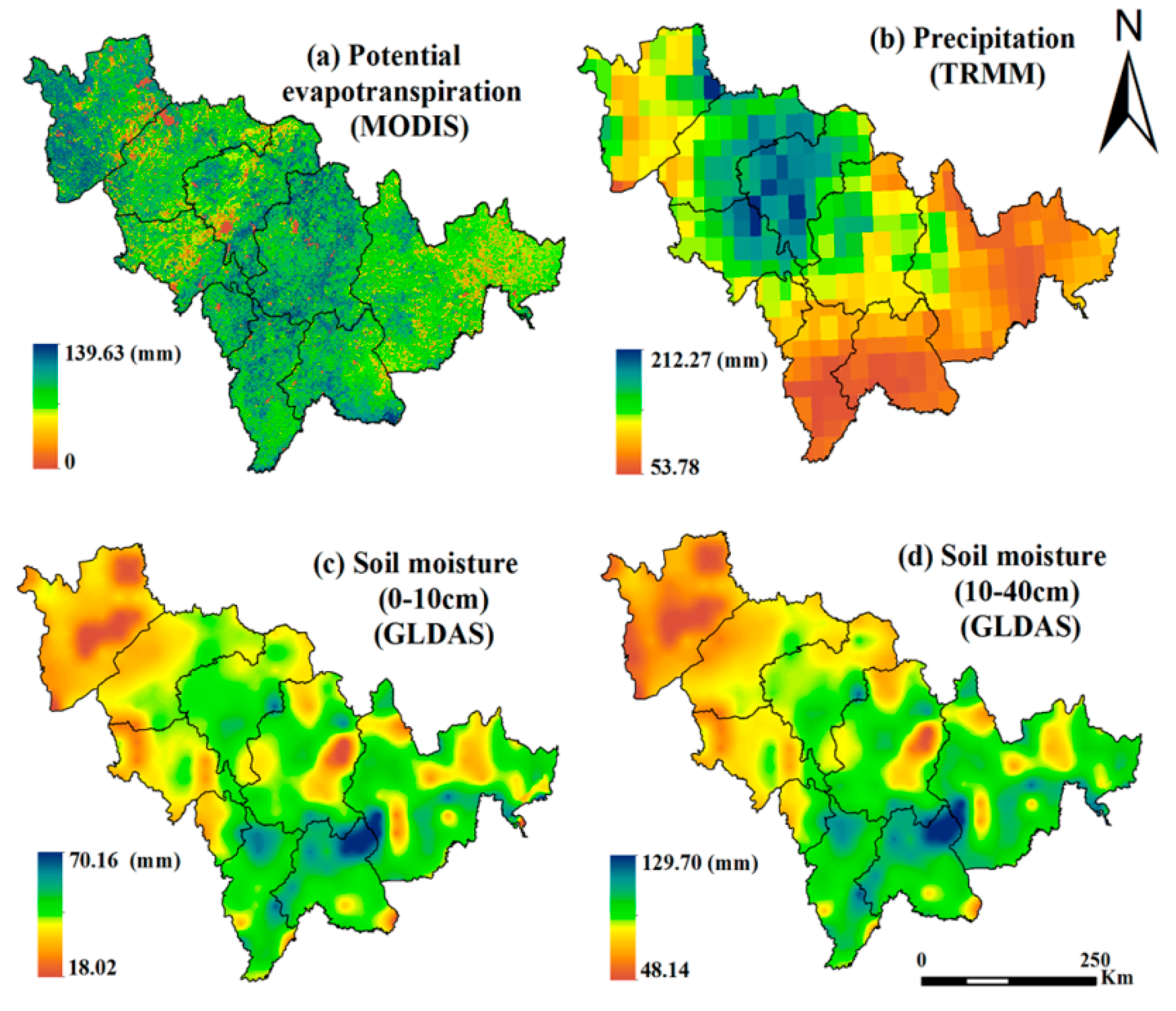
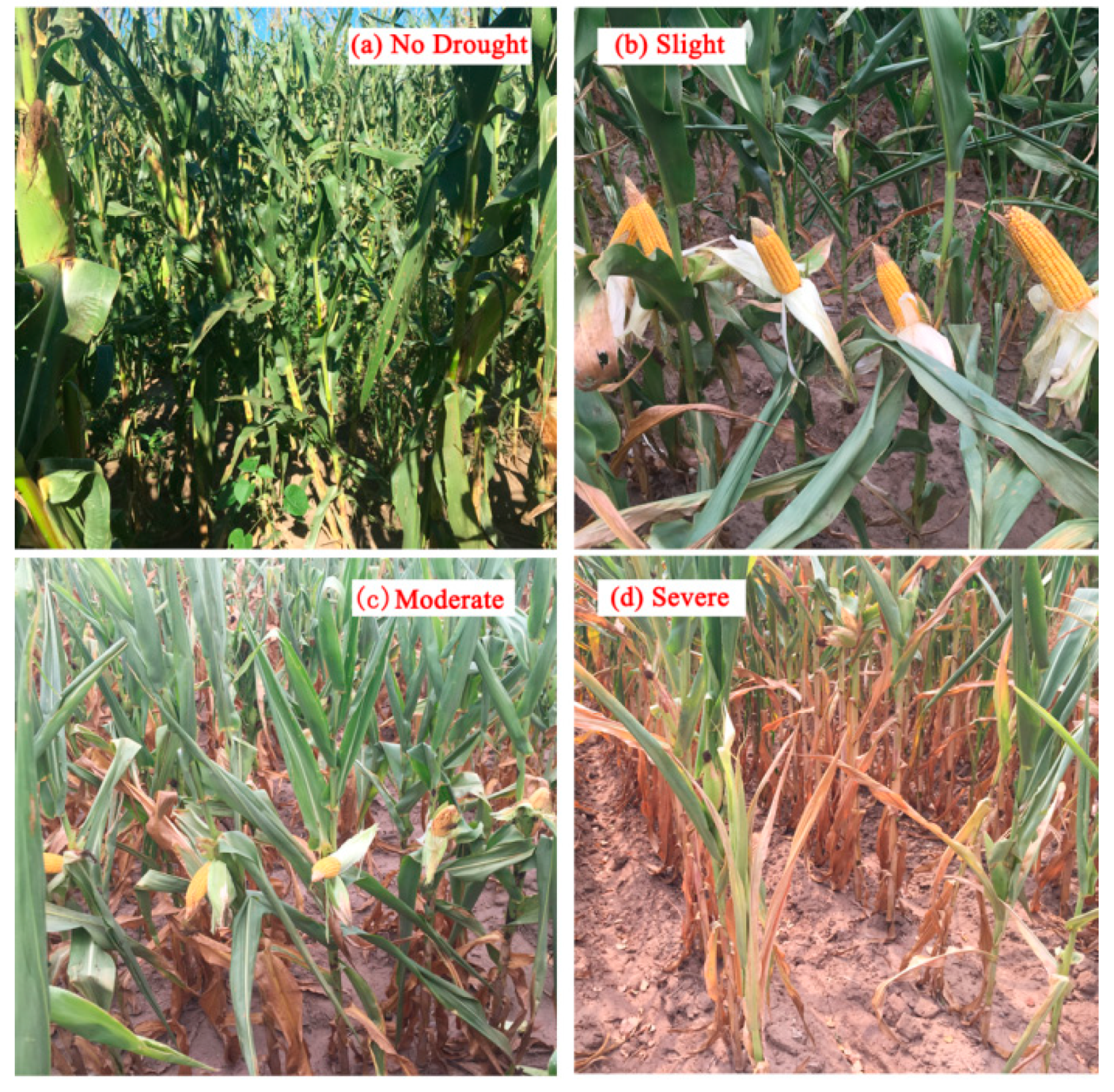
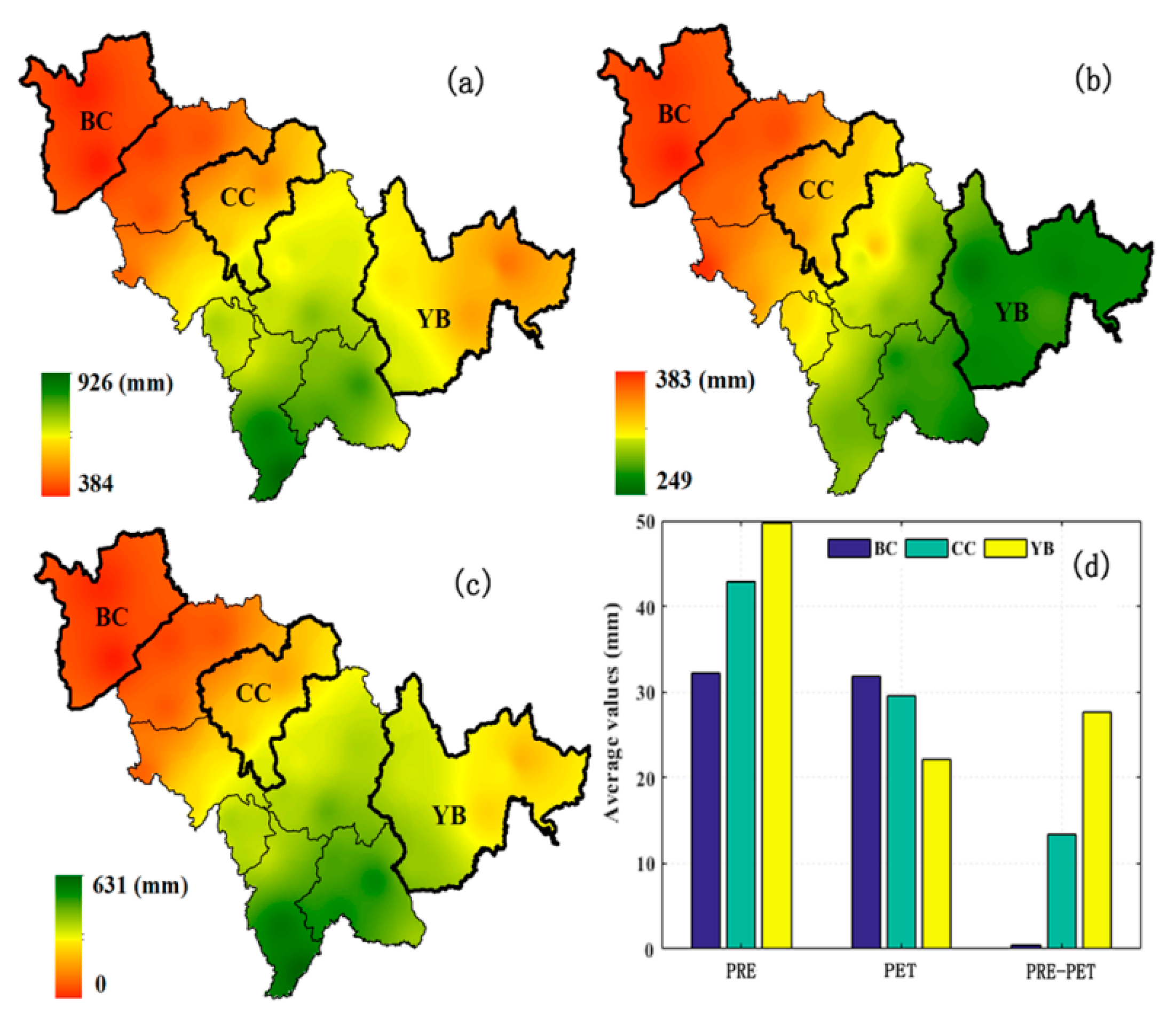
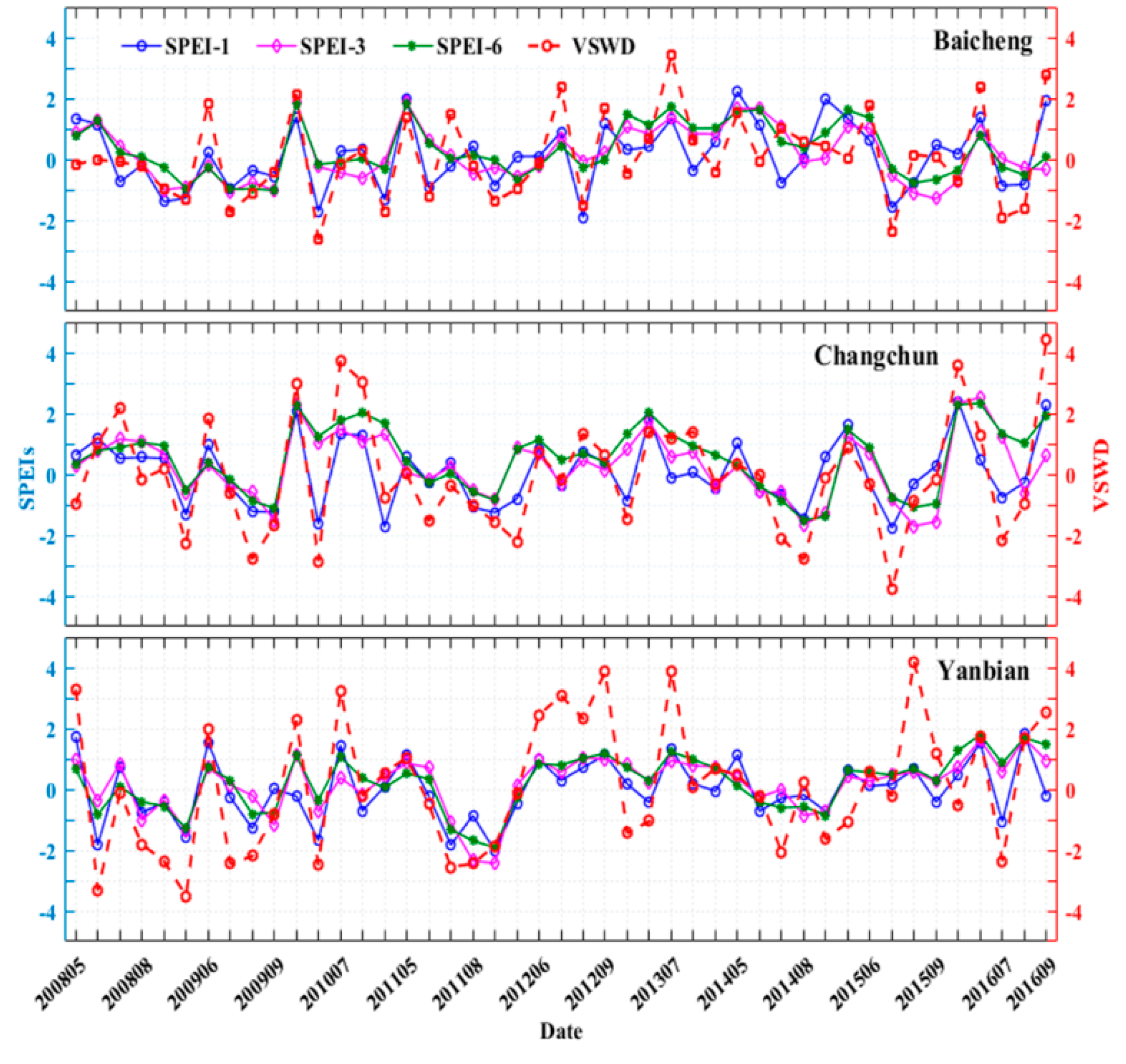

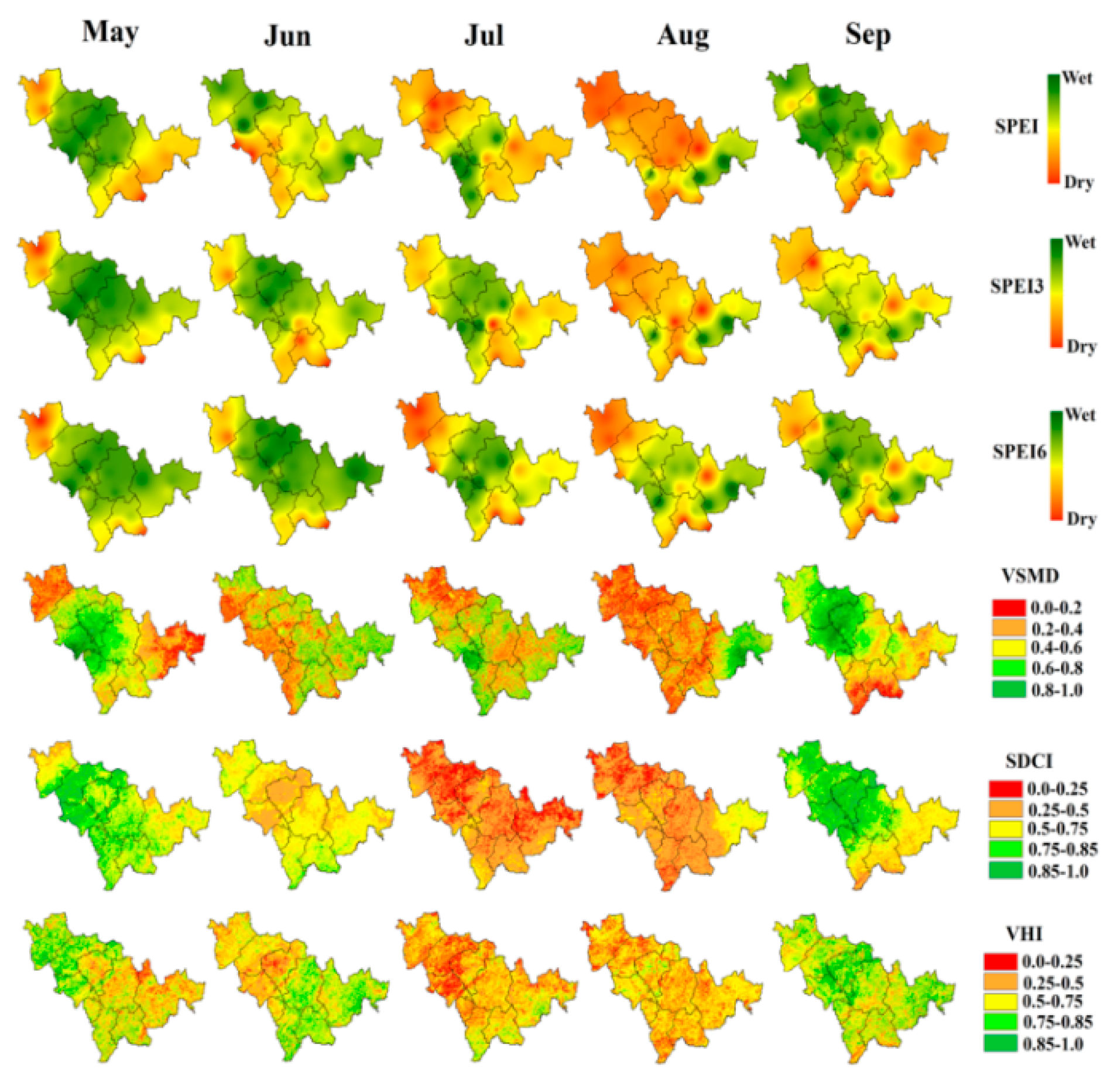

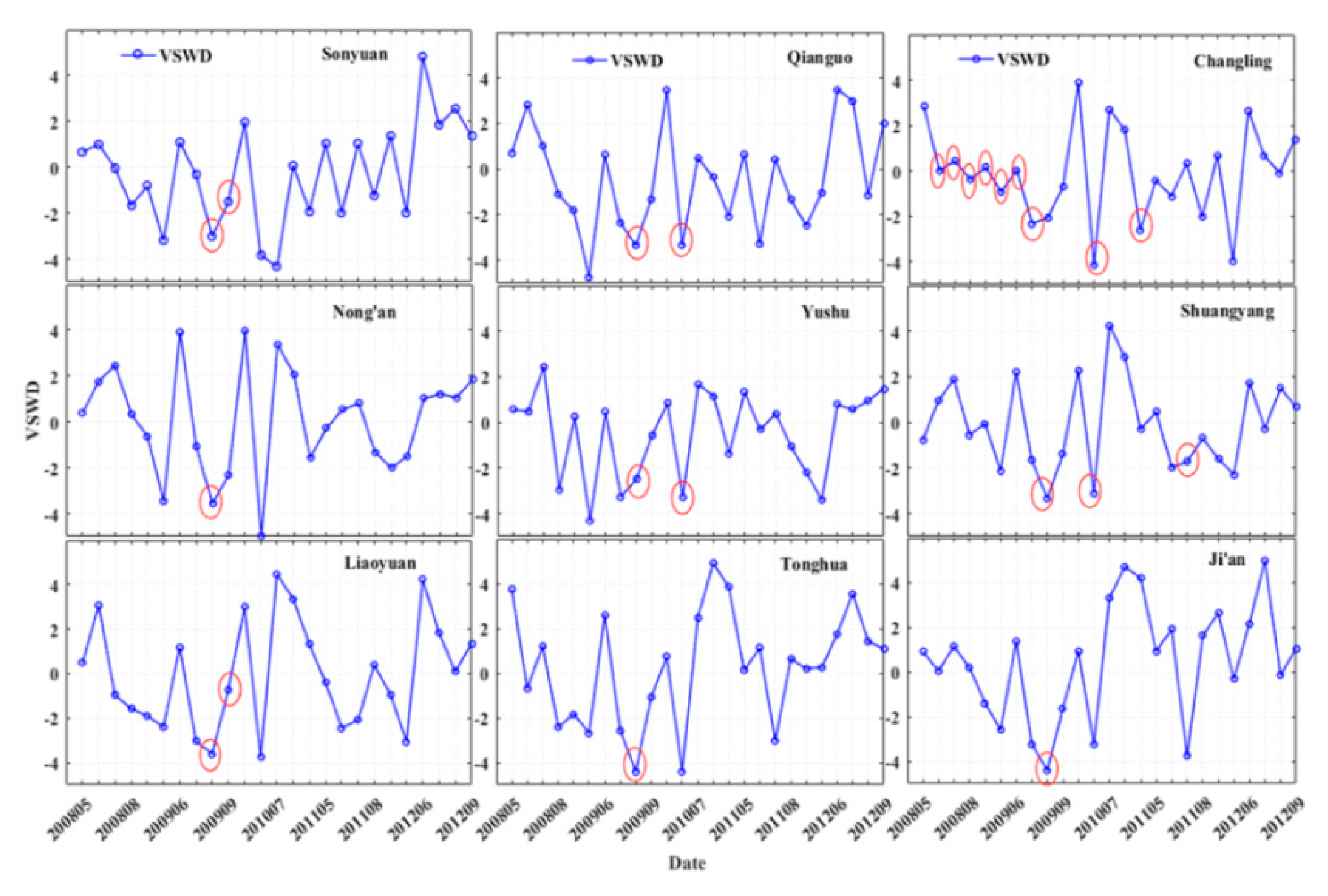
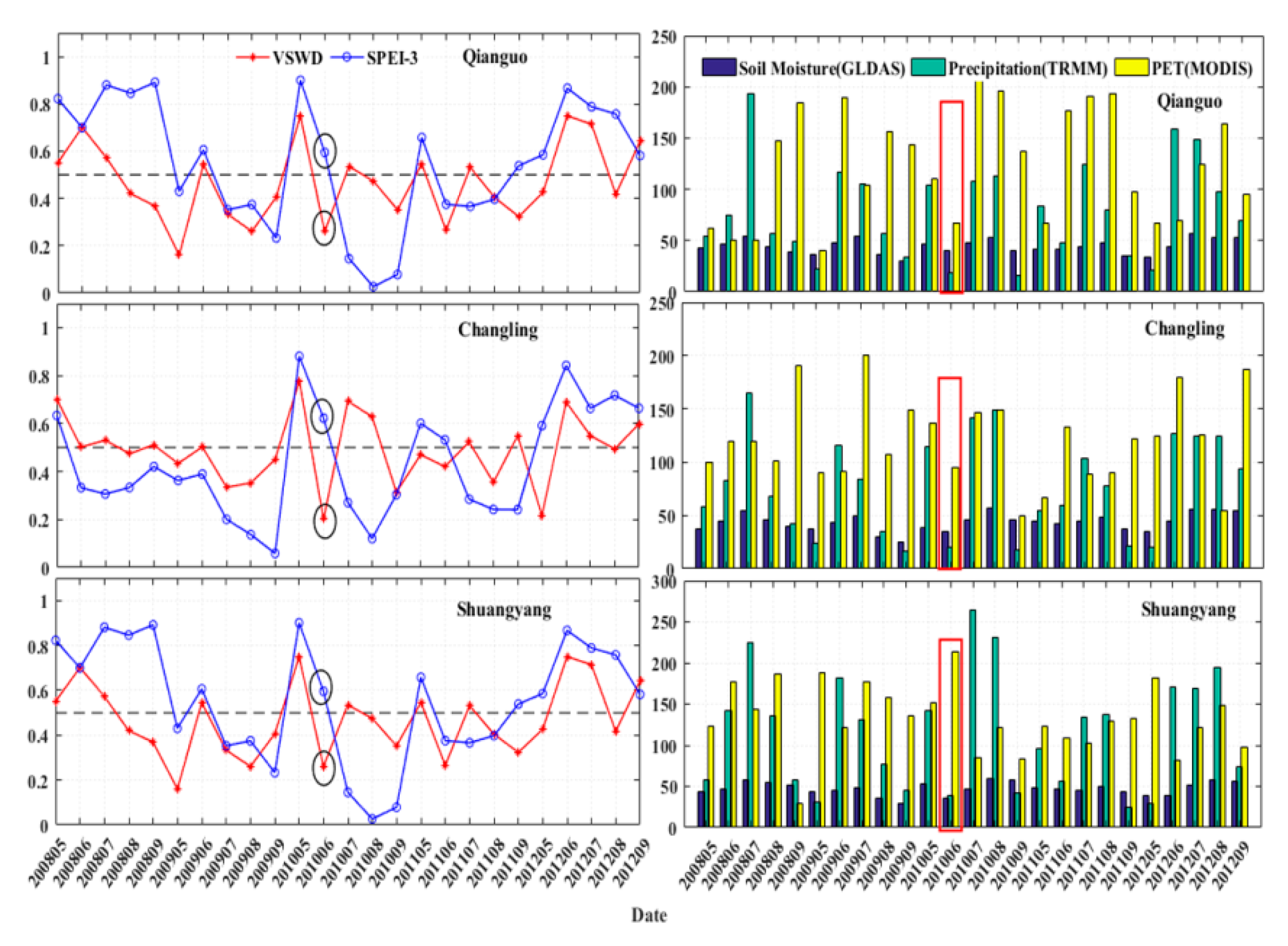

| Mon | Soil_Layer | SPEI-1 | SPEI-3 | SPEI-6 | PDSI | SC-PDSI | Mean Correlation |
|---|---|---|---|---|---|---|---|
| May | S0–10 | 0.83 | 0.91 | 0.85 | 0.38 | 0.47 | 0.69 |
| S0–40 | 0.67 | 0.79 | 0.86 | 0.44 | 0.48 | 0.65 | |
| S10–40 | 0.49 | 0.57 | 0.69 | 0.55 | 0.51 | 0.56 | |
| Jun | S0–10 | 0.26 | 0.10 | 0.20 | 0.14 | 0.33 | 0.21 |
| S0–40 | 0.19 | 0.42 | 0.53 | 0.32 | 0.53 | 0.40 | |
| S10–40 | 0.02 | 0.26 | 0.38 | 0.14 | 0.35 | 0.23 | |
| Jul | S0–10 | 0.60 | 0.52 | 0.59 | 0.54 | 0.44 | 0.54 |
| S0–40 | 0.56 | 0.55 | 0.60 | 0.52 | 0.49 | 0.54 | |
| S10–40 | 0.56 | 0.44 | 0.48 | 0.50 | 0.34 | 0.47 | |
| Aug | S0–10 | 0.29 | 0.45 | 0.69 | 0.57 | 0.52 | 0.50 |
| S0–40 | 0.26 | 0.59 | 0.80 | 0.72 | 0.68 | 0.61 | |
| S10–40 | 0.04 | 0.63 | 0.70 | 0.70 | 0.74 | 0.56 | |
| Sep | S0–10 | 0.87 | 0.28 | 0.42 | 0.40 | 0.26 | 0.45 |
| S0–40 | 0.83 | 0.48 | 0.57 | 0.63 | 0.46 | 0.59 | |
| S10–40 | 0.82 | 0.63 | 0.69 | 0.63 | 0.59 | 0.67 |
| Mon | Method | Baicheng | Changchun | Yanbian | Mean | ||||||
|---|---|---|---|---|---|---|---|---|---|---|---|
| SPEI-1 | SPEI-3 | SPEI-6 | SPEI-1 | SPEI-3 | SPEI-6 | SPEI-1 | SPEI-3 | SPEI-6 | |||
| May | VSWD | 0.833 | 0.885 | 0.811 | 0.944 | 0.817 | 0.781 | 0.690 | 0.777 | 0.579 | 0.791 |
| SDCI | 0.695 | 0.584 | 0.497 | 0.940 | 0.694 | 0.612 | 0.888 | 0.593 | 0.425 | 0.659 | |
| VHI | 0.116 | 0.357 | 0.381 | 0.583 | 0.212 | 0.090 | 0.431 | 0.026 | −0.177 | 0.224 | |
| Jun | VSWD | 0.768 | 0.258 | 0.265 | 0.878 | 0.305 | 0.292 | 0.954 | 0.813 | 0.829 | 0.596 |
| SDCI | 0.59 | 0.145 | 0.196 | 0.942 | 0.319 | 0.352 | 0.889 | 0.698 | 0.633 | 0.529 | |
| VHI | 0.258 | 0.009 | 0.066 | 0.814 | 0.405 | 0.432 | 0.649 | 0.549 | 0.37 | 0.395 | |
| Jul | VSWD | 0.861 | 0.810 | 0.846 | 0.932 | 0.694 | 0.729 | 0.829 | 0.571 | 0.693 | 0.774 |
| SDCI | 0.616 | 0.753 | 0.763 | 0.808 | 0.639 | 0.672 | 0.677 | 0.497 | 0.468 | 0.655 | |
| VHI | 0.270 | 0.012 | 0.032 | 0.054 | 0.073 | 0.108 | −0.753 | −0.590 | −0.530 | −0.147 | |
| Aug | VSWD | 0.625 | 0.200 | 0.641 | 0.912 | 0.777 | 0.840 | 0.757 | 0.670 | 0.701 | 0.680 |
| SDCI | 0.103 | 0.367 | 0.469 | 0.91 | 0.741 | 0.78 | 0.764 | 0.498 | 0.644 | 0.586 | |
| VHI | 0.097 | 0.381 | 0.349 | 0.074 | 0.076 | −0.098 | −0.038 | −0.150 | −0.037 | 0.073 | |
| Sep | VSWD | 0.852 | 0.122 | 0.177 | 0.886 | 0.428 | 0.605 | 0.708 | 0.786 | 0.884 | 0.605 |
| SDCI | 0.770 | 0.006 | 0.096 | 0.842 | 0.252 | 0.402 | 0.844 | 0.754 | 0.827 | 0.533 | |
| VHI | 0.438 | 0.108 | 0.044 | 0.548 | 0.163 | 0.237 | 0.317 | 0.363 | 0.431 | 0.294 | |
| Station | Drought Months (China Drought Disaster Dataset) | ||||
|---|---|---|---|---|---|
| SY (Songyuan) | 200908 | 200909 | |||
| QG (Qianguo) | 200908 | 201006 | |||
| CL (Changling) | 200806 | 200807 | 200808 | 200809 | |
| 200905 | 200906 | 200907 | 200908 | 200909 | |
| 201006 | 201007 | 201009 | |||
| NA (Nong’an) | 200908 | ||||
| YS (Yushu) | 200908 | 201006 | |||
| SY (Shuangyang) | 200908 | 201006 | 201107 | ||
| LY (Liaoyuan) | 200908 | 200909 | |||
| TH (Tonghua) | 200908 | ||||
| JA (Ji’an) | 200908 | ||||
© 2019 by the authors. Licensee MDPI, Basel, Switzerland. This article is an open access article distributed under the terms and conditions of the Creative Commons Attribution (CC BY) license (http://creativecommons.org/licenses/by/4.0/).
Share and Cite
Cao, Y.; Chen, S.; Wang, L.; Zhu, B.; Lu, T.; Yu, Y. An Agricultural Drought Index for Assessing Droughts Using a Water Balance Method: A Case Study in Jilin Province, Northeast China. Remote Sens. 2019, 11, 1066. https://doi.org/10.3390/rs11091066
Cao Y, Chen S, Wang L, Zhu B, Lu T, Yu Y. An Agricultural Drought Index for Assessing Droughts Using a Water Balance Method: A Case Study in Jilin Province, Northeast China. Remote Sensing. 2019; 11(9):1066. https://doi.org/10.3390/rs11091066
Chicago/Turabian StyleCao, Yijing, Shengbo Chen, Lei Wang, Bingxue Zhu, Tianqi Lu, and Yan Yu. 2019. "An Agricultural Drought Index for Assessing Droughts Using a Water Balance Method: A Case Study in Jilin Province, Northeast China" Remote Sensing 11, no. 9: 1066. https://doi.org/10.3390/rs11091066
APA StyleCao, Y., Chen, S., Wang, L., Zhu, B., Lu, T., & Yu, Y. (2019). An Agricultural Drought Index for Assessing Droughts Using a Water Balance Method: A Case Study in Jilin Province, Northeast China. Remote Sensing, 11(9), 1066. https://doi.org/10.3390/rs11091066





